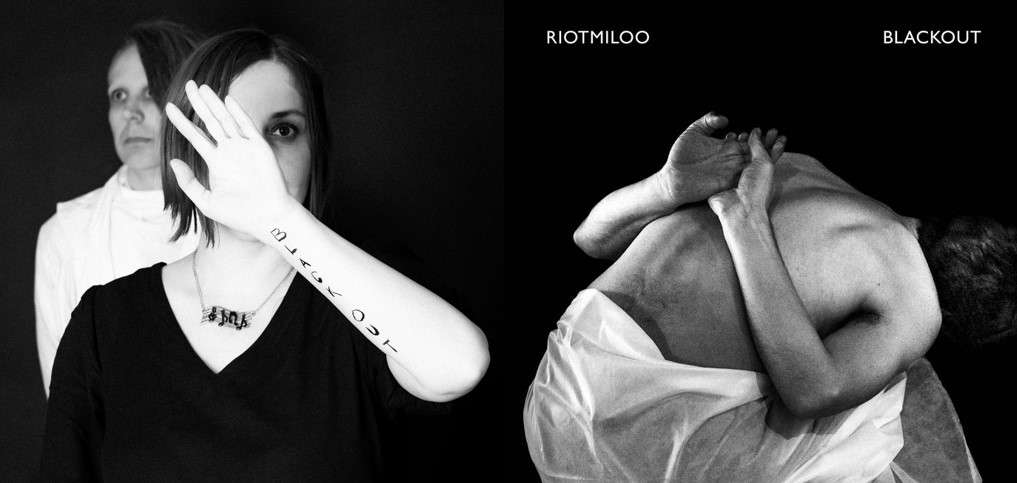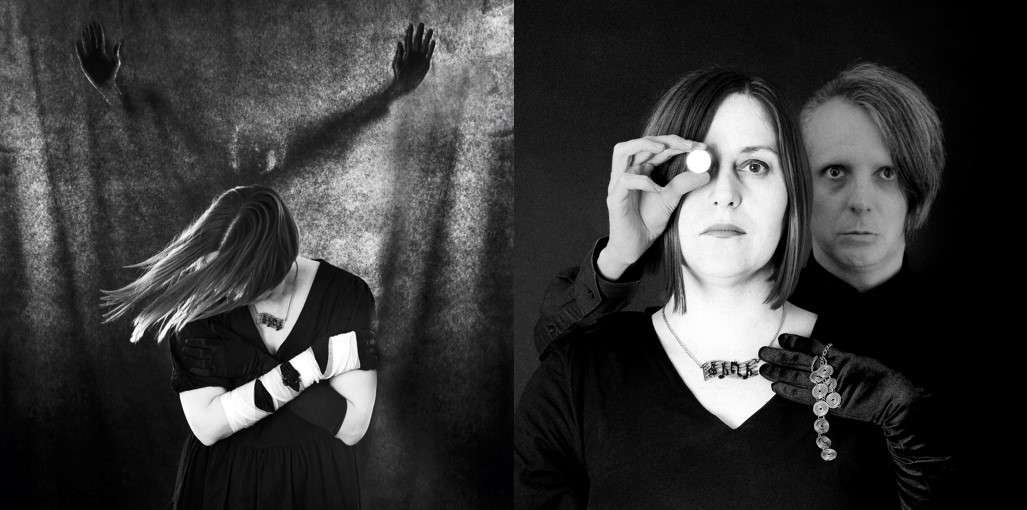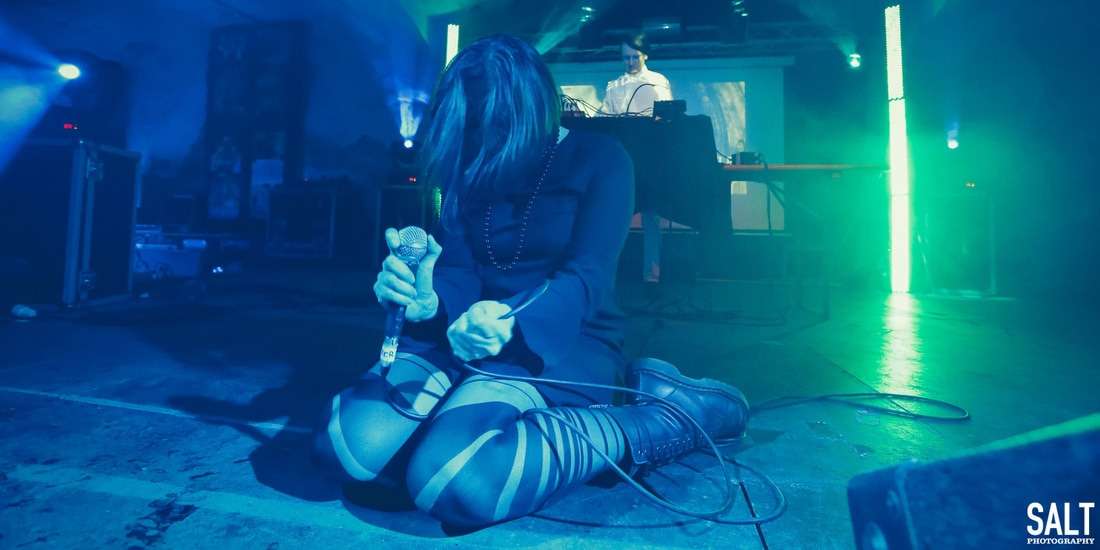Riotmiloo ist das elektronische Musikprojekt der französischen Künstlerin Emilie. Mit ihrer Musik erschafft sie eine elektrisierende und dunkle Atmosphäre und erforscht dabei die Grenzen neuer Klangspektren. Riotmiloos Kunst „zeigt düstere Elemente der menschlichen Psyche und präsentiert verstörende Elemente des Geschichtenerzählens.“ Der zweite Longplayer Blackout, der über das Label Ant-Zen veröffentlicht wurde, ist eins meiner Lieblingsalben und elektronischen Highlights des letzten Jahres. Die acht Tracks auf Blackout sind ein ganz eigenes, unglaublich spannendes und experimentelles Klanguniversum!

Fotos: © Esmeralda Muñoz-Torrero
Who is behind Riotmiloo? What made you decide to start the project?
Hi, my name is Emilie and Riotmiloo is my musical alter ego. It started a while back in the early 2000s to channel various strong feelings, one of them being to address the need to have more female representation in music. I started as a vocalist in an experimental punk band in London called 3 Ant Riot (LINK). I then joined a riotgrrrl inspired punk garage band called Venom Seeds (LINK). Both projects ended and Riotmiloo evolved a lot since then, becoming more and more active in electronic and particularly industrial genres.
If you had to describe your music in terms of not music … what would you say?
It’s raw, it’s meant to stop you in your tracks and make you pause and think. My music aims to channel various feelings which form the core of my Art. It depicts gloomy elements of the human psyche and presents disturbing elements of story-telling.
Forget about genres for a second – Riotmiloo´s music sounds like …
… something claustrophobic and oppressive. It takes you on a journey ranging from melancholic soundscapes to full on raging assault. It takes you by surprise and hopefully leaves you with many questions about yourself and the world we live in.
What are you looking for in music? What are the boundaries that you look to explore with music?
With music, I like to explore many themes that many may want to shy away from. With “Blackout”, the concept was to create a visceral and raw sonic depiction of internal turmoil while aiming to dismantle the artificial barriers between normality and madness, tearing down the notion of stigma.
What is sound to you?
To me, sounds illustrate various moods. Sounds provide a strong foundation where lyrics and poetry can be embedded in it. They feed off each other to create something stronger than the sum of its parts. In recent years, my interest towards analogue sounds grew stronger and I began to embrace it more and more.

Fotos: © Esmeralda Muñoz-Torrero
What are your first musical memories? When did you first fall in love with sound?
I grew up in France and the very first bands that caught my interest were Les Rita Mitsouko and Brigitte Fontaine, both quite unconventional at the time. The first were a duo that played some hybrid pop punk synth pops anthems. Brigitte Fontaine is an avant-garde singer who explored many musical styles from rock, jazz to electronica while adding spoken words, poetry and tongue in cheek lyrics. Attending live shows as a very young adult really made me fall in love with music. The loudness of it, getting lost into the music was a life changing experience. I just didn’t know then that I would one day fall in love with performing live myself.
Which person, artist or incident inspired you when you first started making music?
I started making music a bit by accident. My friends had a band and the vocalist couldn’t attend the rehearsal. I filled in at first and ended up singing later for other friends at the end of their gig. The audience immediately noticed my intense stage presence and encouraged me to carry on. I was initially inspired by the punk hardcore scene, then by the riotgrrrl movement and when I discovered Hanin Elias and the whole Digital Hardcore scene, it really inspired me. I then left France to live in London and started my electronic experimental music journey with my first band 3 Ant Riot.
What impact do your surroundings have on your art?
The world we live in is so harsh and so judgemental. I am inspired by politics, by feminism, by many real-life stories and more generally what makes us human. I am lucky I live in London and I get to see and feel the art created by other people.
Where does your inspiration for music come from? Which sort of mood produces the best song?
Sadness, despair and anger usually fuel my inspiration. I like to describe the ugly, hidden or unspoken side of things.

Foto: © s.alt @ elektroanschlag 2017 www.ant-zen.com/salt
Recently your album “Blackout“ came out. How did the writing happen? How did the idea and concept get seeded and what was the process like to turn these thoughts into music?
The writing of the album “Blackout” started a few years ago. It took a long time to get it where I wanted it. The first song that we finished was “Blackout”, I wanted to explore more oppressive sounds using analogue machines as well as having a go at making my own sort of angst pop inspired album. The initial concept was to illustrate various states of mental suffering without naming them, trying to establish a state a confusion and paralysis where my music, my voice and my lyrics would invite the listener to feel distress and recognise their own suffering and their own journey to overcome it, hoping to open conversations about mental health.
Eva|3 helped me a lot with the writing of the music and the process of turning my ideas into a sombre melancholic and sometimes menacing music. His attention to detail and music knowledge helped me shape and define the very unique sound found on “Blackout”.
How does the visual aspect relate to and reflect your music?
The visual aspect adds another layer to the music. I am extremely grateful to Esmeralda Muñoz Torrero who managed to capture the tension in the human body via her amazing photographic work. Stefan Alt from ant-zen also helped create a magnificent LP, using layers and die cut cardboard. The artwork created for “Blackout” has been carefully crafted, like the music and I am so proud of it.
Previously, I worked with an American photographer called Jessica Hosman and used her amazing double exposure photographic work as visuals throughout live shows. Those photographs ended up providing the backdrop of a special performance where they were projected onto us, both performers, adding an eerie and mysterious layer to the concert. This was recorded and reworked to create a DVD, “Riotmiloo Live at Iklectik”, with the aim of taking the viewer through a raw and cathartic visual and audio experience, oscillating between aggression and hopelessness.
How would you describe the world you are trying to create during your performances?
My performances are usually quite intense. It is a real exchange of energy between the audience and myself. I invite people to join me in a heightened sensitivity experience where music is pushed to the max. I also like to get off stage and confront the audience while singing.
What’s next for you? What are you most looking forward to?
The feedback for “Blackout” has been phenomenal. I am so grateful to all the positive messages, the radio plays all over the world, the wonderful remixes on the single “Folie À Deux”, the reviews and the interviews. I think the next stage is to prepare myself to play the new album live. By the way, I will be playing in Berlin for the Berlin Furore Festival (LINK) at Backsteinboot, 19th and 20th of July alongside Hypnoskull, Supersimmetria, Capsular and more. I will also be looking for more opportunities to perform live throughout 2024 and beyond.
Webseite Bandcamp Facebook Instagram
(1145)
